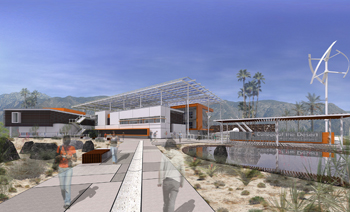College Commits to Sustainability in Palm Springs
 LOS ANGELES — HGA Architects and Engineers’ (HGA) Los Angeles office has completed the design for Phase I of the new West Valley Campus at College of the Desert in Palm Springs, Calif.
LOS ANGELES — HGA Architects and Engineers’ (HGA) Los Angeles office has completed the design for Phase I of the new West Valley Campus at College of the Desert in Palm Springs, Calif.
The project sets new standards for sustainable design and bringing high-performance building technologies into the college’s curriculum. The construction of the project is expected to begin this July.
“The College of the Desert’s vision for a self-sustaining campus is to produce more energy than it consumes,” said James Matson, AIA, vice president and director of HGA’s Los Angeles office, in a statement. “The plan emphasizes energy production along with substantial conservation and energy efficiency, waste recovery and biomimicry in partnership with green industries and education initiatives. The campus will consider the site’s unique ecology and natural resources to create a national model for sustainable research and teaching that supports the local economy and educational needs in Coachella Valley.”
The project includes 50,000 square feet of academic space and is slated for completion in January 2015. The campus will feature wind turbines, solar panels and a culinary arts center, among other highlights.
“The overall design vision for this project is focused on making it a national model for innovative sustainable strategies,” said Satoshi Teshima, AIA, LEED AP, project designer, in a statement. “The result will be an iconic campus that not only serves as a landmark and gateway to Palm Springs, but reflects the city’s history of mid-century modern architecture.”
Along with HGA working on the design, Tempe, Ariz.-based Sundt Construction is serving as the construction manager on the project. Both companies have a strong commitment to sustainable building, which can be seen directly in the design plans for the College of the Desert.
“This project has forward-thinking goals that go beyond net-zero energy to embrace a zero-plus plan that creates renewable clean energy rather than simply using less energy,” said Patrick Thibaudeau, LEED AP, vice president of sustainable design at HGA, in a statement. “The zero-plus plan targets five integrated sustainable goals — zero-plus energy, carbon, water, waste and materials. The plan emphasizes on-site electricity production through photovoltaic solar panels and establishes consumption targets to be less than or equal to available resources.”
The College of the Desert’s new West Valley Campus is not the only project at the college taking place. HGA is also working with the college’s Applied Sciences Building, which includes new construction and renovation of an existing building on the Palm Desert campus and is targeted to achieve LEED Silver certification.
